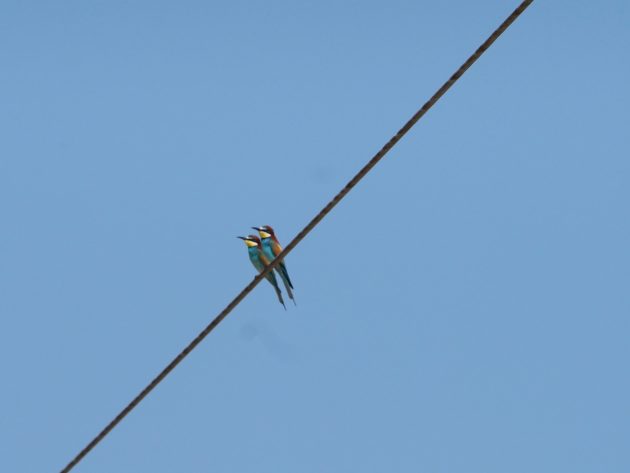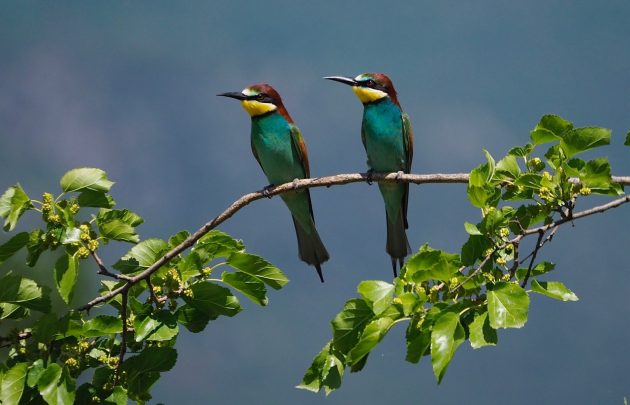A couple of years ago my friend Martin Tickler called me late on a grey Sunday afternoon. “You won’t believe this, David, but there’s a flock of nine Bee-eaters sitting on the wires in the field behind my house.” Bee-eaters are one of the most colourful, and beautiful, of all European birds, but they are very scarce visitors to Britain. The prospect of seeing nine in my home county of Suffolk was irresistible. “I’m coming!” I told Martin, grabbing my binoculars and camera as I spoke.
Martin lives in the quaintly named village of Pixey Green: it took me 30 minutes to arrive at his house. He greeted me on his drive. “Yes, they’re still here, and there’s 15 of them.” Fifteen? I’d have been happy with just a couple. I was led through Martin’s densely vegetated garden to a gap in the hedge, looking out over his neighbour’s fields, one of hay, the other winter barley. As we walked I could hear the Bee-eaters calling to each other, that beautiful, distinctive, rolling call that always reminds me of sun-baked hills in the Mediterranean.
One of the Pixey Green Bee-eater flock, May 2022. This was the best photograph I managed on a dull, grey May afternoon
Suddenly, there they were, a whole line of birds on the wires, plus individuals swooping after insects. The word swooping is often misused, but no other bird swoops quite like a Bee-eater. Martin said that he had noted that the birds were paired, as there was courtship feeding going on, with individual birds returning to their partners to present them with a choice bug. As I watched I kept on counting, not easy with so much happening, but I reached a peak of 17, a score echoed by Martin’s wife, Gay. There was probably an 18th somewhere around that we didn’t manage to see.
As I was armed with my camera and long lens I was anxious to get pictures as proof of this extraordinary sight, but this wasn’t as easy as you might imagine. The wires the birds were using were about 60 yards away, so almost out of range of the camera, while the birds themselves were surprisingly wary. As if this wasn’t a sufficient challenge, there was the light, or rather the lack of it. It was dull and flat, the sun obscured by thick cloud. If there’s a bird that need sunlight to be seen at its best, then it is undoubtedly the Bee-eater. My dream of getting a stunning photograph was not to be. I took 150 shots, of which a few were OK, but no more, and I did get a photograph with 15 birds in view at once. A picture of all 17 eluded me.

Part of the flock of 17 birds in Suffolk. The light was dreadful for trying to take photographs
I had been enjoying watching the birds for perhaps 40 minutes when I heard the alarm calls of House Martins (Martin has a colony of between 20 and 30 pairs nesting on his house): they had been alarmed by a passing sparrowhawk. The Bee-eaters clearly heard the warning calls, too, as suddenly they were up and away. I was sure that such a large flock of these stunning birds would be reported elsewhere in Suffolk or Norfolk, but they just disappeared, never to be seen again. Incidentally, it’s worth mentioning that Martin is convinced that it was the House Martins that decoyed in the Bee-eaters in the first place, and I am sure that he is right. The Bee-eater flock was no doubt flying over when it heard the calls of the House Martins, so came down to investigate.

Watching the Bee-eaters: the RSPB watchpoint, June 2022
Three weeks after our sighting of the flock the RSPB announced that three pairs of Bee-eaters were nesting in a disused quarry near the coastal village of Trimingham, in North Norfolk (50 miles to the north). This was the first time Bee-eaters had nested in Britain since 2014 (the first-ever successful nesting in Britain was in Sussex in 1955). Thanks to a friendly land-owner, the Norfolk site was opened for visitors, and thousands of people came to see them. It would have been fascinating to know whether any of the Trimingham bee-eaters were the same birds that I had seen in Suffolk.

Most views of the Trimingham birds were quite distant, like this pair sitting on wires. Fine for birdwatchers, not so good for photographers
I visited the Trimingham site several times that summer, taking friends who wanted to see the birds. Each time there was a small crowd of fellow watchers. Some were serious birdwatchers, but many were people who were just interested and had come to see what all the fuss was about. The RSPB had volunteers on hand with telescopes to ensure that everyone got good views.

About my best shot of the Trimingham birds. They never came close to me
The Trimingham Bee-eaters bred successfully, and much to everyone’s surprise, five birds returned the following spring. This was the first time that Bee-eaters had returned to a nesting site in Britain. Frustratingly, they were not successful: it was suspected that their nest was predated by either Weasels or Stoats. (Bee-eaters are ground nesters, laying their eggs in tunnels that they excavate, making them vulnerable to ground predators like Weasels). The RSPB had opened its watch point for a second year, but it was closed early as though the birds remained in the area for some time, they rarely returned to the quarry.

This pair of Bee-eaters was photographed in Northern Greece, where they are common breeding birds
After last year’s failure hopes aren’t high the Bee-eaters will return to the same site again this year, but in recent summers increasing numbers of Bee-eaters have been recorded in England, so there’s a good chance that they might try and breed somewhere else. They are late migrants here, as the best time to see them is in late May or early June, while there’s a distinct southerly and easterly bias to the counties where they have been seen.

Bee-eaters are ground nesters, making them vulnerable to predation
The flock of 17 at Pixey Green holds the record for the biggest flock in the UK this century, and the second biggest ever. The record, a flock of 18 birds, was seen in Oxfordshire in 1997. The number of birds recorded in Britain has been increasing annually in recent years, for it seems that they like our warming climate, so it’s a distinct possibility that these lovely birds will become regular nesters here in the UK in the years to come.

Source link

